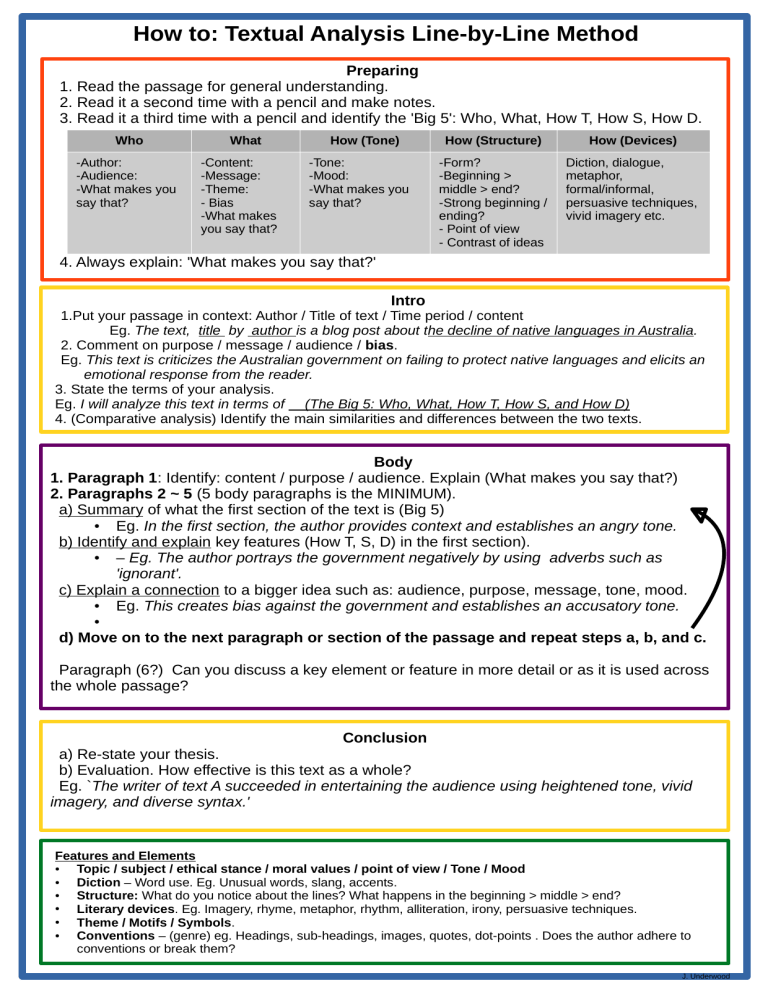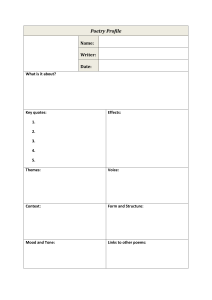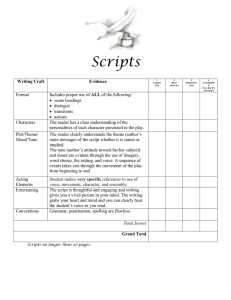
How to: Textual Analysis Line-by-Line Method Preparing 1. Read the passage for general understanding. 2. Read it a second time with a pencil and make notes. 3. Read it a third time with a pencil and identify the 'Big 5': Who, What, How T, How S, How D. Who -Author: -Audience: -What makes you say that? What -Content: -Message: -Theme: - Bias -What makes you say that? How (Tone) -Tone: -Mood: -What makes you say that? How (Structure) How (Devices) -Form? -Beginning > middle > end? -Strong beginning / ending? - Point of view - Contrast of ideas Diction, dialogue, metaphor, formal/informal, persuasive techniques, vivid imagery etc. 4. Always explain: 'What makes you say that?' Intro 1.Put your passage in context: Author / Title of text / Time period / content Eg. The text, title by author is a blog post about the decline of native languages in Australia. 2. Comment on purpose / message / audience / bias. Eg. This text is criticizes the Australian government on failing to protect native languages and elicits an emotional response from the reader. 3. State the terms of your analysis. Eg. I will analyze this text in terms of (The Big 5: Who, What, How T, How S, and How D) 4. (Comparative analysis) Identify the main similarities and differences between the two texts. Body 1. Paragraph 1: Identify: content / purpose / audience. Explain (What makes you say that?) 2. Paragraphs 2 ~ 5 (5 body paragraphs is the MINIMUM). a) Summary of what the first section of the text is (Big 5) ● Eg. In the first section, the author provides context and establishes an angry tone. b) Identify and explain key features (How T, S, D) in the first section). ● – Eg. The author portrays the government negatively by using adverbs such as 'ignorant'. c) Explain a connection to a bigger idea such as: audience, purpose, message, tone, mood. ● Eg. This creates bias against the government and establishes an accusatory tone. ● d) Move on to the next paragraph or section of the passage and repeat steps a, b, and c. Paragraph (6?) Can you discuss a key element or feature in more detail or as it is used across the whole passage? Conclusion a) Re-state your thesis. b) Evaluation. How effective is this text as a whole? Eg. `The writer of text A succeeded in entertaining the audience using heightened tone, vivid imagery, and diverse syntax.' Features and Elements ● Topic / subject / ethical stance / moral values / point of view / Tone / Mood ● Diction – Word use. Eg. Unusual words, slang, accents. ● Structure: What do you notice about the lines? What happens in the beginning > middle > end? ● Literary devices. Eg. Imagery, rhyme, metaphor, rhythm, alliteration, irony, persuasive techniques. ● Theme / Motifs / Symbols. ● Conventions – (genre) eg. Headings, sub-headings, images, quotes, dot-points . Does the author adhere to conventions or break them? J. Underwood How to: Textual Analysis Text Elements Method Preparing 1. Read the passage for general understanding. 2. Read it a second time with a pencil and make notes. 3. Read it a third time with a pencil and identify the 'Big 5': Who, What, How T, How S, How D. Who -Author: -Audience: -What makes you say that? What -Content: -Message: -Theme: - Bias -What makes you say that? How (Tone) -Tone: -Mood: -What makes you say that? How (Structure) How (Devices) -Form? -Beginning > middle > end? -Strong beginning / ending? - Point of view - Contrast of ideas Diction, dialogue, metaphor, formal/informal, persuasive techniques, vivid imagery etc. 4. Always explain: 'What makes you say that?' Intro 1.Put your passage(s) in context: Author / Title of text / Time period / content Eg. The text, title by author is a blog post about the decline of native languages in Australia. 2. Comment on purpose / message / audience / bias. Eg. This text is criticizes the Australian government on failing to protect native languages and elicits an emotional response from the reader. 3. State the terms of your analysis. Eg. I will analyze this text in terms of (The Big 5: Who, What, How T, How S, and How D) 4. (Comparative analysis) Identify the main similarities and differences between the two texts. Body Paragraph 1: Purpose Paragraph 2: Audience Paragraph 3: Message / Bias (Depending on the text, these might each get a paragraph.) Paragraph 4: Theme / Mood / Tone. (Depending on the text). Paragraphs 5-7: Stylistic Devices. Don't lump all stylistic devices into one paragraph. Group them. Eg. Imagery, Sound, Persuasive, Biased, Poetic. Paragraph 8: Structure. Conclusion a) Re-state your thesis. b) (Comparative analysis) Identify the main similarities and differences between the two texts. c) Evaluation. How effective is this text(s) as a whole? Eg. `The writer of text A succeeded in entertaining the audience using heightened tone, vivid imagery, and diverse syntax.' Features and Elements ● Topic / subject / ethical stance / moral values / point of view / Tone / Mood ● Diction – Word use. Eg. Unusual words, slang, accents. ● Structure: What do you notice about the lines? What happens in the beginning > middle > end? ● Literary devices. Eg. Imagery, rhyme, metaphor, rhythm, alliteration, irony, persuasive techniques. ● Theme / Motifs / Symbols. ● Conventions – (genre) eg. Headings, sub-headings, images, quotes, dot-points . Does the author adhere to conventions or break them? J. Underwood How to: Structure your Comparative Analysis Method 2: Element by Element Method 1: Text by Text Introduction: Identify main similarity and difference Introduction: Identify main similarity and difference Text 1: Purpose Text 1: Purpose Text 1: Audience Text 2: Transition sentence + Purpose + link to text 1 Text 1: Message / Bias SL Text 1: Theme / Mood / Tone Text 1: Audience Text 1: Stylistic Devices Text 2: Audience + link to text 1 Text 1: Structure Text 1: Message / Bias Text 2: Transition sentence + Purpose + link to text 1 Text 2: Message / Bias + link to text 1 HL Text 1: Theme / Mood / Tone Text 2: Audience + link to text 1 Text 2: Message / Bias + link to text 1 Text 2: Theme / Mood / Tone + link to text 1 Text 2: Theme / Mood / Tone + link to text 1 Text 1: Stylistic Devices Text 2: Stylistic Devices Text 1: Structure Text 2: Stylistic Devices Text 2: Structure Text 2: Structure ● Conclusion: Identify main similarity and difference ● Evaluate effectiveness of the texts. ● Conclusion: Identify main similarity and difference ● Evaluate effectiveness of the texts. J. Underwood How to: Write Topic Sentences The role of the writer Language Device or Stylistic Technique The writer's use of... Symbolism Contrast Setting Imagery Rhetoric Strong adjectives Rhyme Repetition Punctuation Short sentences Verb to Show Effect or Function Conveys Captures Connotes Demonstrates Emphasizes Highlights Hints at Illustrates Implies Reinforces Reflects Shows Signifies Suggests Symbolizes Underlines Underscores Function / Effect / Idea / Theme / Mood / Message / Bias for the film A sense of tragedy A light mood The theme of ambition Adapted from: Hedges, Laurence, Lance King, Macclure Graham, and Swash Laura. Approaches to Learning: A Practical Guide, 2012. How to: Integrate Quotes 1. Transition phrase + quote The third technique used in this poem is repetition of a stanza which emphasizes the idea of hope found in that stanza. For instance, the stanza beginning with, ‘The caged bird sings with a fearful trill’ is repeated two times in this poem. The author's fearful language suggests that even with the fear of racism, African Americans during this time period continued to hope for freedom and equality. That is to say, 'the caged bird sings of freedom.' 2. Drop in Breaking it down Quoting 1. Context: Who says it and when do they say it? Transition phrase 2. Transition phrase. 3. What the quote proves. 4. The quote 5. The quote's function. What the quote proves Context: Who says it? Macbeth is aware of the negative consequences of his ambition. For instance he says, 'Stars, hide your fires; / Let not light see my black and deep desires.' Macbeth's description of his 'desires' as 'black' suggests wrong-doing. The quote The quote's function J. Underwood


